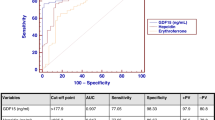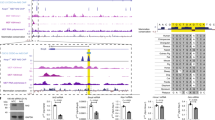Abstract
In thalassemia, deficient globin-chain production during erythropoiesis results in anemia1,2,3. Thalassemia may be further complicated by iron overload (frequently exacerbated by blood transfusion), which induces numerous endocrine diseases, hepatic cirrhosis, cardiac failure and even death4. Accumulation of iron in the absence of blood transfusions may result from inappropriate suppression of the iron-regulating peptide hepcidin by an erythropoietic mechanism5. To test this hypothesis, we examined erythroblast transcriptome profiles from 15 healthy, nonthalassemic donors. Growth differentiation factor 15 (GDF15), a member of the transforming growth factor-β superfamily, showed increased expression and secretion during erythroblast maturation. Healthy volunteers had mean GDF15 serum concentrations of 450 ± 50 pg/ml. In comparison, individuals with β-thalassemia syndromes had elevated GDF15 serum levels (mean 66,000 ± 9,600 pg/ml; range 4,800–248,000 pg/ml; P < 0.05) that were positively correlated with the levels of soluble transferrin receptor, erythropoietin and ferritin. Serum from thalassemia patients suppressed hepcidin mRNA expression in primary human hepatocytes, and depletion of GDF15 reversed hepcidin suppression. These results suggest that GDF15 overexpression arising from an expanded erythroid compartment contributes to iron overload in thalassemia syndromes by inhibiting hepcidin expression.
This is a preview of subscription content, access via your institution
Access options
Subscribe to this journal
Receive 12 print issues and online access
$209.00 per year
only $17.42 per issue
Buy this article
- Purchase on Springer Link
- Instant access to full article PDF
Prices may be subject to local taxes which are calculated during checkout




Similar content being viewed by others
References
Rund, D. & Rachmilewitz, E. β-thalassemia. N. Engl. J. Med. 353, 1135–1146 (2005).
Pootrakul, P. et al. A correlation of erythrokinetics, ineffective erythropoiesis, and erythroid precursor apoptosis in Thai patients with thalassemia. Blood 96, 2606–2612 (2000).
Nathan, D.G. Thalassemia as a proliferative disorder. Medicine (Baltimore) 43, 779–782 (1964).
Weatherall, D.J. & Clegg, J.B. The Thalassaemia Syndromes (4th ed.) (Blackwell Scientific, Oxford, 2001).
Nemeth, E. & Ganz, T. Regulation of iron metabolism by hepcidin. Annu. Rev. Nutr. 26, 323–342 (2006).
Donovan, A., Roy, C.N. & Andrews, N.C. The ins and outs of iron homeostasis. Physiology (Bethesda) 21, 115–123 (2006).
Ganz, T. Hepcidin—a regulator of intestinal iron absorption and iron recycling by macrophages. Best Pract. Res. Clin. Haematol. 18, 171–182 (2005).
Papanikolaou, G. et al. Hepcidin in iron overload disorders. Blood 105, 4103–4105 (2005).
Kattamis, A. et al. The effects of erythropoetic activity and iron burden on hepcidin expression in patients with thalassemia major. Haematologica 91, 809–812 (2006).
Weizer-Stern, O. et al. Downregulation of hepcidin and haemojuvelin expression in the hepatocyte cell–line HepG2 induced by thalassaemic sera. Br. J. Haematol. 135, 129–138 (2006).
Wang, R.H. et al. A role of SMAD4 in iron metabolism through the positive regulation of hepcidin expression. Cell Metab. 2, 399–409 (2005).
Babitt, J.L. et al. Bone morphogenetic protein signaling by hemojuvelin regulates hepcidin expression. Nat. Genet. 38, 531–539 (2006).
Truksa, J., Peng, H., Lee, P. & Beutler, E. Bone morphogenetic proteins 2, 4, and 9 stimulate murine hepcidin 1 expression independently of Hfe, transferrin receptor 2 (Tfr2), and IL-6. Proc. Natl. Acad. Sci. USA 103, 10289–10293 (2006).
Massague, J. TGF-β signal transduction. Annu. Rev. Biochem. 67, 753–791 (1998).
de Caestecker, M. The transforming growth factor-β superfamily of receptors. Cytokine Growth Factor Rev. 15, 1–11 (2004).
Wojda, U., Noel, P. & Miller, J.L. Fetal and adult hemoglobin production during adult erythropoiesis: coordinate expression correlates with cell proliferation. Blood 99, 3005–3013 (2002).
Yamamoto, Y. & Oelgeschlager, M. Regulation of bone morphogenetic proteins in early embryonic development. Naturwissenschaften 91, 519–534 (2004).
Sritippayawan, S. et al. Restrictive lung disease and serum TGF-β1 in thalassemia major children. Asian Pac. J. Allergy Immunol. 23, 121–126 (2005).
Eling, T.E. et al. NSAID activated gene (NAG-1), a modulator of tumorigenesis. J. Biochem. Mol. Biol. 39, 649–655 (2006).
Marjono, A.B. et al. Macrophage inhibitory cytokine-1 in gestational tissues and maternal serum in normal and pre-eclamptic pregnancy. Placenta 24, 100–106 (2003).
Hromas, R. et al. PLAB, a novel placental bone morphogenetic protein. Biochim. Biophys. Acta 1354, 40–44 (1997).
Millard, K.N., Frazer, D.M., Wilkins, S.J. & Anderson, G.J. Changes in the expression of intestinal iron transport and hepatic regulatory molecules explain the enhanced iron absorption associated with pregnancy in the rat. Gut 53, 655–660 (2004).
Welsh, J.B. et al. Large-scale delineation of secreted protein biomarkers overexpressed in cancer tissue and serum. Proc. Natl. Acad. Sci. USA 100, 3410–3415 (2003).
Koopmann, J. et al. Serum markers in patients with resectable pancreatic adenocarcinoma: macrophage inhibitory cytokine 1 versus CA19–9. Clin. Cancer Res. 12, 442–446 (2006).
Yang, H., Filipovic, Z., Brown, D., Breit, S.N. & Vassilev, L.T. Macrophage inhibitory cytokine-1: a novel biomarker for p53 pathway activation. Mol. Cancer Ther. 2, 1023–1029 (2003).
Xu, J. et al. GDF15/MIC-1 functions as a protective and antihypertrophic factor released from the myocardium in association with SMAD protein activation. Circ. Res. 98, 342–350 (2006).
Hsiao, E.C. et al. Characterization of growth-differentiation factor 15, a transforming growth factor β superfamily member induced following liver injury. Mol. Cell. Biol. 20, 3742–3751 (2000).
Kearney, S.L. et al. Urinary hepcidin in congenital chronic anemias. Pediatr. Blood Cancer 48, 57–63 (2007).
Rao, K.R., Patel, A.R., McGinnis, P. & Patel, M.K. Iron stores in adults with sickle cell anemia. J. Lab. Clin. Med. 103, 792–797 (1984).
Inamura, J. et al. Upregulation of hepcidin by interleukin-1β in human hepatoma cell lines. Hepatol. Res. 33, 198–205 (2005).
Acknowledgements
The National Institutes of Health Department of Transfusion Medicine, National Institute of Diabetes and Digestive and Kidney Diseases Microarray Core Laboratory, and S. Strom, J. Goodnough, G. Moser and M. Ehinger performed or assisted with studies involving hepatocytes and transgenic mice. We thank C. Deng, C. Philpott, and A. Schechter for critical reading of the manuscript. This research was supported by the Intramural Research Program of the National Institutes of Health, National Institute of Diabetes and Digestive and Kidney Diseases.
Author information
Authors and Affiliations
Contributions
T. T., manuscript writing, performed experiments, assembly of data. N.V.B., collection and assembly of array data. P.A.O., collection of clinical samples and data. S.-H.G., provision of study material, array data analysis. P.S., collection of clinical samples and data. Y.T.L., collection and assembly of array data. J.W.M., collection of clinical samples. C.H.R., collection of clinical samples and data. N.L.C.L., collection of clinical samples and data. R.-H.W., expertise with hepatic iron assessment. T.E., expertise with GDF15 transgenic mouse. R.C., collection of clinical samples and data. T.G., mouse GDF15 analyses, manuscript revision. S.F.L., collection of clinical samples and data. S.F., collection of clinical samples and data. J.L.M., manuscript writing, experimental conception and design, assisted and supervised research team.
Corresponding author
Ethics declarations
Competing interests
A provisional patent (Application No. 601864.705) was generated on the basis of these findings.
Supplementary information
Supplementary Text and Figures
Supplementary Tables 1 & 2 (PDF 191 kb)
Rights and permissions
About this article
Cite this article
Tanno, T., Bhanu, N., Oneal, P. et al. High levels of GDF15 in thalassemia suppress expression of the iron regulatory protein hepcidin. Nat Med 13, 1096–1101 (2007). https://doi.org/10.1038/nm1629
Received:
Accepted:
Published:
Issue Date:
DOI: https://doi.org/10.1038/nm1629
This article is cited by
-
GDF15 linked to maternal risk of nausea and vomiting during pregnancy
Nature (2024)
-
Changes of biomarkers for erythropoiesis, iron metabolism, and FGF23 by supplementation with roxadustat in patients on hemodialysis
Scientific Reports (2023)
-
Molecular insights into placental iron transfer mechanisms and maternofetal regulation
Archives of Gynecology and Obstetrics (2023)
-
Low Serum Hepcidin Levels in Patients with Ulcerative Colitis – Implications for Treatment of Co-existent Iron-Deficiency Anemia
Inflammation (2023)
-
Neonatal hemochromatosis with εγδβ-thalassemia: a case report and analysis of serum iron regulators
BMC Pediatrics (2022)



